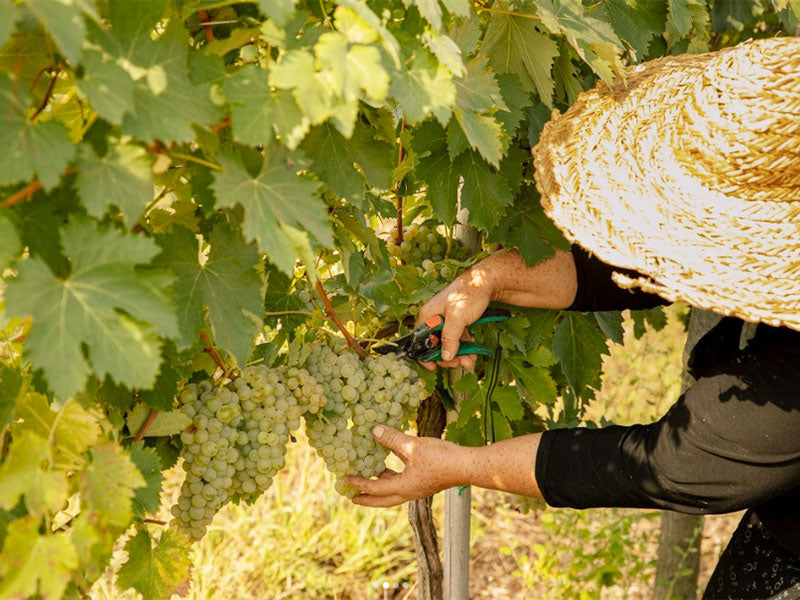Old World. New Flavors.
Of the over 10,000 different grape varieties in the world, 525 hail from and have evolved in Georgia over the millennia and still remain unique to the territory today. Here are our top 10, creating Georgia’s most delicious wines:
Red Grape Varieties
Saperavi
Pronounced: sah-peh-RAH-vee
Viticulture and winemaking: This late-ripening teinturier grape (red skin and red flesh) produces wines that are deep purple, almost opaque black in color; Saperavi is also commonly used to make vibrant, magenta-hued dry rosés.
Smell and taste: Juicy blood orange, snappy pomegranate, ripe black cherry, cassis, smoked bay leaf, crushed black peppercorn, dark cocoa, worn leather, fresh tobacco. Lifted and mouthwatering with bright acidity but dark fruit flavors and fine-grained tannins. Intriguing, complex, characterful.
If you like these, try Saperavi: dark, bold, dry reds like Cabernet Sauvignon, Syrah, Malbec, or Aglianico
Aleksandrouli
Pronounced: ah-lek-sahn-DROO-lee
Viticulture and winemaking: This late-ripening variety hails from the Racha region in Western Georgia, where it thrives on the sunny, calcareous, southern slopes of the Caucasus Mountains. Often harvested late to craft semi-sweet wines, it also makes beautiful dry, aromatic reds.
Smell and taste: Sun-ripened strawberry, black raspberry, wild Amarena cherry, black plum compote, dried rose petal, fresh potting soil, licorice, star anise, violet. Soft, supple and plush with mellow acidity and mild tannins. Easy-drinking, perfumed, lightly spiced.
If you like these, try Saperavi: medium-weight, fruit-forward reds like Grenache, Merlot, California Pinot Noir, or Tempranillo
White and Amber Grape Varieties
White and amber wines start with the same white grape varietals… the difference arises from the fermentation process: White wines have no skin contact, whereas ambers are made with the juice fermenting in contact with the crushed grape skins. We’ve included tasting notes below that are typical for each grape’s most common production styles.
Goruli Mtsvane
Pronounced: go-ROO-lee mih-ts-VAH-nay
Viticulture and winemaking: Mtsvane means “green” — a reference to the grape’s color, especially as it is quite late-ripening — and Goruli nods to its hometown of Gori in the Kartli region of Georgia. It’s often blended with Chinuri, also from Kartli. Do not confuse Goruli Mtsvane with straight Mtsvane… or with Mtsvane Kakhuri, which are different varieties altogether!
Smell and taste: Key lime, Meyer lemon, wild Alpine herbs, lily, honeycomb. Spirited, bright, inviting.
If you like these, try Goruli Mtsvane: fresh, clean and citrusy whites like French Sauvignon Blanc, Pinot Grigio, Grüner Veltliner
Tsolikouri
Pronounced: shoh-li-KOO-ree
Viticulture and winemaking: This is a versatile white variety especially popular in Imereti in western Georgia. It’s late-ripening and produces wines with full body, good for aging, that are made into a range of styles from dry to semi-sweet as well as sparkling.
Smell and taste: ripe Bartlett pear, apricot, quince jam, persimmon, marzipan. Weighty, rich, softer acidity. Approachable, adaptable, full-fruited.
If you like these, try Tsolikouri: full, ripe and expressive whites like Chardonnay, Viognier, Chenin Blanc
Chkhaveri
Pronounced: SHKAW-veh-ree
Viticulture and winemaking: This dark pink-skinned variety is found mostly in western Georgia, where its very late-ripening nature means it’s typically harvested at the end of November, still claiming high acidity. It plays well in dry or semi-sweet as well as still or sparkling styles. It’s commonly fermented/aged on its skins to draw out a deep pink color and added texture in the finished wine.
Smell and taste: Rainier cherry, fresh raspberry, Mirabelle plum skin, candied red apple, magnolia, dried rose petal. Succulent, brisk, full of tart acidity and length.
If you like these, try Chkhaveri: deeply colored yet dry rosés, Italian ramato-style Pinot Grigio, or light, savory and chillable reds like Gamay or Barbera
Rkatsiteli
Pronounced: re-KAT-si-teh-lee
Viticulture and winemaking: Rkatsiteli is a mash-up of root words rka meaning “vine shoot” and tsiteli meaning “red”... you can guess what the stems look like, then, of this ancient variety. It dates back to the 1st century — legend has it Rkatsiteli was the first grape planted by Noah after the flood — and today is the most widely planted grape in Georgia. It’s especially common in the Kakheti region, where it’s prized for its high acidity and propensity for qvevri aging. It’s commonly blended with Mtsvane and other white varieties.
Smell and taste: Without skin contact, in white wine form, Rkatsiteli shows floral, bright, white peach, quince and golden apple notes. In amber or orange wine versions, usually fermented and aged in qvevri, Rkatsiteli showcases intense yet fine-grained tannins and exotic, lightly spiced and floral notes like dried apricot and cherry, orange marmalade, membrillo, peat, dried marigold, rooibos. Grippy, savory, finessed and complex.
If you like these, try Rkatsiteli: other orange/amber wines, California Chardonnay, or fine-tannin reds such as Italian Sangiovese like Chianti or Brunello
Mtsvane Kakhuri
Pronounced: mih-ts-VAH-nay KA-KHOO-ree (say the “kh” sound with a very soft, almost imperceptible “k” and a throaty “hhh” sound)
Viticulture and winemaking: This variety of Mtsvane (which means “green” in Georgian, and which generally refers to a whole group of genetically distinct but related varieties) is specific to the region of Kakheti. Mtsvane Kakhuri is earlier ripening, productive, and maintains acidity even at higher sugar levels. Most typically, Mtsvane Kakhuri is made in qvevri, with skin contact.
Smell and taste (in amber wine form, which is most common for Mtsvane Kakhuri): orange Tootsie Pop, brûléed pineapple, dried mango, toasted walnut, maple candy, terra cotta. Crisp, dense, textural.
If you like these, try Mtsvane Kakhuri: other orange/amber wines, tannic and dried-fruit reds like Nebbiolo, or light-bodied chilled red wines
Kisi
Pronounced: KEE-see
Viticulture and winemaking: Kisi is an early-ripening variety touting brisk acidity and vibrant floral aromas. While it’s made into both fresh white wines (often called “European” style) as well as aged skin-contact ambers, it’s particularly prized for its exotic aromatics in the latter.
Smell and taste: As a white wine (fermentation/aging without skin contact), Kisi is boisterous and tropical, evoking kiwi, star fruit, papaya, jasmine and fresh lilies. In amber form, Kisi evolves into enchanting, herbal and heady dried spearmint, apricot jam, poached pear, calendula, tobacco and walnut butter. Vibrant, exuberant, exotic.
If you like these, try Kisi: aromatic whites with good acidity like Albariño, Sauvignon Blanc, or dry Riesling (all three in either white or amber forms)
Khikhvi
Pronunciation: HEE-kh-vee (say the “kh” sound with a very soft, almost imperceptible “k” and a throaty “hhh” sound)
Viticulture and winemaking: This relatively rare grape is native to the Kakheti region, where it’s made into both amber and classic European white wines as well as both dry and sweet styles, prized for its ability to maintain acidity white accumulating higher levels of sugar and ripeness.
Smell and taste: In dry white form: juicy, vibrant and tangy tangerine, pomelo, peach candy and orange blossom. In amber form: velvety, evocative and savory: candied grapefruit peel, roasted pumpkin seed, red miso and caramel.
If you like these, try Khikhvi: citrusy and savory whites like French Chardonnay or Chenin Blanc, or other orange/amber wines
Chinuri or Chinebuli
Pronunciation: shi-NOO-ree
Viticulture and winemaking: Whether named for the color of olive tree leaves (chini) or the Georgian word for “excellent” (chinebuli), this variety is abundant, late-budding and late-ripening. It’s native to the Kartli region and is most commonly made into the crisp sparkling wines of the Atenuri appellation.
Smell and taste: Wild mint, fresh pear, forest moss, fennel, white apricot. Soft, herbal, pretty.
If you like these, try sparkling Chinuri: other fruity and fresh sparkling wines like pét-nats or Prosecco





